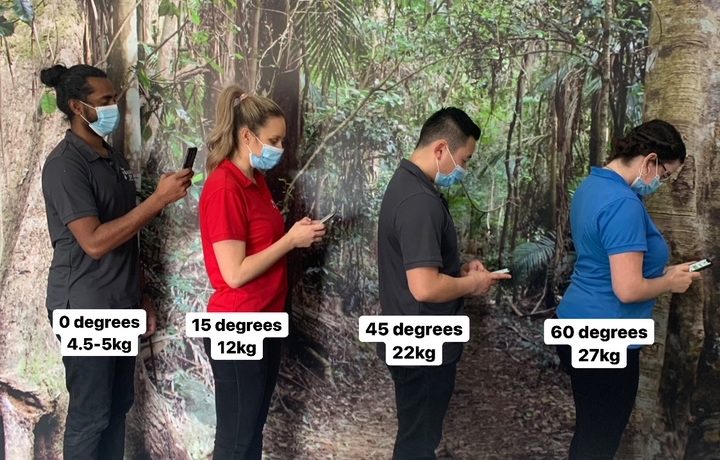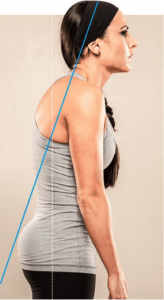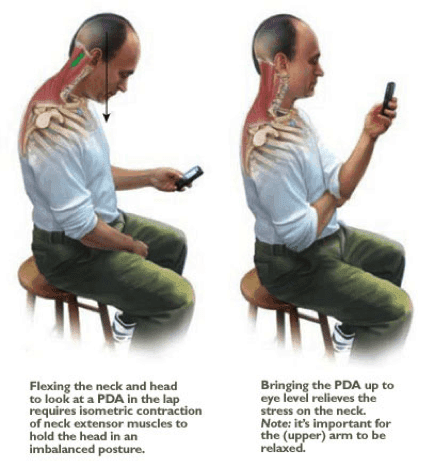
[vc_row][vc_column][vc_column_text]As COVID lockdown continues there has been an increase in the number of patients with neck related pain and/or stiffness. A recent study shows that 79% of the population between the ages 18-44 have their mobile phones with them almost all the time, with only 2 hours of their waking day spent without their cell on hand.
“Text neck” is actually a term that has been used to describe the posture formed by leaning forward for prolonged periods. Inherently there is nothing wrong with this position, however spending too much time like this can result in cervical (neck), TMJ (jaw), thoracic (upper back) and shoulder pain, as well as headaches. The most common condition that contributes to neck pain is being in one position or posture for too long.
Being in one position for too long is often a result of work and/or study and it can be helpful to understand that during these times you may be:
A combination of these factors can lead to an increase in tension in your muscles and stiffness through your joints. Doing this day after day can then lead to all the nasty symptoms previously mentioned.
Contrary to popular belief, science has yet to establish a universally agreed upon ideal posture (O’Sullivan et al., 2021). Supplementing this, the evidence mixed as to whether sitting in one particular posture predisposes you to pain more so than another (Richards et al., 2017). Ultimately, there is a large variance amongst different people and different ages and the specific posture you adapt is probably just one piece of a multi-piece puzzle of why you have pain and tightness (Richards et al., 2021).

Forward head posture is when the neck slants forward placing the head in front of the shoulders This picture is an exaggeration of the posture seen when mobile phones and screens are used frequently.
Sometimes in the clinic, we will see people coming in with neck and upper back pain related to being in one position for too long. Generally, this will be in a more rounded position. Hence, the position can become sensitised and uncomfortable, particularly when you spend a significant amount of time like this. If this is the case for you, then trying to be more conscious of your posture can be helpful to reduce your pain and get you feeling better.
If you have spent an extended period of time in a flexed posture, try changing things up by having your ears aligned with your shoulder, and your shoulder blades resting in a retracted (squared) position.
On average we spend roughly 2-4 hours a day with our heads tilted over, reading and texting on smartphones and other handheld devices (kindle, ipads,laptops). A high school student can be up to an extra 5000 hours a year in this position.
The diagram below summarises the effects of tilting our heads and the extra load through our spine with increasing flexion.

With a seemingly innocent tilt of the head, you are actually exerting increased load with increasing flexion.
As you can see the greater the angle of tilt the more load is going through our neck. At 60 degrees of flexion there is a greater load going through your neck, which most of the time it is resilient enough to handle. However, spend too long in one position and combine it with added stress and you have a strong recipe for muscle tightness and pain.
This also applies to those of you using a laptop and iPad screen to do work at home.

Spend less time on a hand held device.

Laura is demonstrating a gentle upper trap stretch. Look towards your armpit and apply gentle pressure on the top of your head
Don’t ignore the signs. Listen to your body, if you are getting neck pain, have it seen to. One of our talented team members will be able to assess your neck, and provide you with advice, strength and stretching exercises, postural aids and bracing can minimise the risk of long term issues or discomfort.
O’Sullivan K., O’Sullivan P., O’Sullivan L. & Dankaerts W. (2012). What do physiotherapists consider to be the best sitting spinal posture? Manual therapy. 17(5):432-7. doi: 10.1016/j.math.2012.04.007
Richards K., Beales D., Smith A., O’Sullivan P. & Straker L. (2017). Neck Posture Clusters and Their Association With Biopsychosocial Factors and Neck Pain in Australian Adolescents. Physical Therapy, Volume 96, Issue 10, 1 October 2016, Pages 1576–1587, https://doi.org/10.2522/ptj.20150660
Richards K., Beales D., Smith A., O’Sullivan P. & Straker L. (2021).Is Neck Posture Subgroup in Late Adolescence a Risk Factor for Persistent Neck Pain in Young Adults? A Prospective Study. Physical Therapy. Mar 3;101(3):pzab007. doi: 10.1093/ptj/pzab007.[/vc_column_text][/vc_column][/vc_row][vc_row][vc_column][vc_column_text][/vc_column_text][/vc_column][/vc_row]